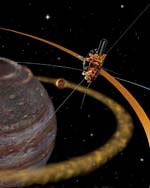
Image credit: ESA
In a repeat performance of its groundbreaking discovery in 1992, the DUST instrument on board Ulysses has detected streams of dust particles flowing from Jupiter during the recent second encounter with the giant planet.
The dust streams, comprising grains no larger than smoke particles, originate in the fiery volcanoes of Jupiter?s moon Io. The dust stream particles, which carry an electric charge, are strongly influenced by Jupiter’s magnetic field. Electromagnetic forces propel the dust out of the Jovian system, into interplanetary space.
“The recent observations include the most distant dust stream ever recorded – 3.3 AU (nearly 500 million km) from Jupiter!? said Dr. Harald Kr?ger, from the Max-Planck-Institut f?r Kernphysik in Heidelberg. Another unusual feature is that the streams occur with a period of about 28 days. This suggests that they are influenced by solar wind streams that rotate with the Sun. “Interestingly, the most intense peaks show some fine structure which was not the case in 1992?, said Kr?ger, Principal Investigator for the DUST instrument.
Early on in the history of the solar system, as the planets were being formed, small dust particles were much more abundant. These charged grains were influenced by magnetic fields from the early Sun, in much the same way as the dust from Io is affected by Jupiter’s magnetic field today. “By studying the behaviour of these dust stream particles, we hope to gain an insight into processes that led to the formation of the moons and planets in our solar system?, said Richard Marsden, ESA?s Mission Manager for Ulysses. Dust particles carry information about charging processes in regions of Jupiter?s magnetosphere that are difficult to access by other means.
Original Source: ESA News Release
